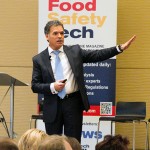References
- Abriouel, H., Benomar, N., Lucas, R., & Gálvez, A. (2011). Culture-independent study of the diversity of microbial populations in brines during fermentation of naturally-fermented Aloreña green table olives. International Journal of Food Microbiology, 144(3), 487–496. https://doi.org/10.1016/j.ijfoodmicro.2010.11.006
- Benson, A. K., David, J. R. D., Gilbreth, S. E., Smith, G., Nietfeldt, J., Legge, R., … Singh, I. (2014). Microbial successions are associated with changes in chemical profiles of a model refrigerated fresh pork sausage during an 80-day shelf life study. Applied and Environmental Microbiology, 80(17), 5178–5194. https://doi.org/10.1128/AEM.00774-14
- Bhatt, V. D., Ahir, V. B., Koringa, P. G., Jakhesara, S. J., Rank, D. N., Nauriyal, D. S., … Joshi, C. G. (2012). Milk microbiome signatures of subclinical mastitis-affected cattle analyzed by shotgun sequencing. Journal of Applied Microbiology, 112(4), 639–650. https://doi.org/10.1111/j.1365-2672.2012.05244.x
- Bokulich, N. A., Bamforth, C. W., & Mills, D. A. (2012). Brewhouse-resident microbiota are responsible for multi-stage fermentation of American coolship ale. PloS One, 7(4), e35507. https://doi.org/10.1371/journal.pone.0035507
- Bokulich, N. A., Lewis, Z. T., Boundy-Mills, K., & Mills, D. A. (2016). A new perspective on microbial landscapes within food production. Current Opinion in Biotechnology, 37, 182–189. https://doi.org/10.1016/j.copbio.2015.12.008
- Callon, C., Retureau, E., Didienne, R., & Montel, M.-C. (2014). Microbial biodiversity in cheese consortia and comparative Listeria growth on surfaces of uncooked pressed cheeses. International Journal of Food Microbiology, 174, 98–109. https://doi.org/10.1016/j.ijfoodmicro.2014.01.003
- Casaburi, A., Piombino, P., Nychas, G.-J., Villani, F., & Ercolini, D. (2015). Bacterial populations and the volatilome associated to meat spoilage. Food Microbiology, 45(Pt A), 83–102. https://doi.org/10.1016/j.fm.2014.02.002
- Chao, Y., Mao, Y., Wang, Z., & Zhang, T. (2015). Diversity and functions of bacterial community in drinking water biofilms revealed by high-throughput sequencing. Scientific Reports, 5. https://doi.org/10.1038/srep10044
- de Boer, P., Caspers, M., Sanders, J.-W., Kemperman, R., Wijman, J., Lommerse, G., … Kort, R. (2015). Amplicon sequencing for the quantification of spoilage microbiota in complex foods including bacterial spores. Microbiome, 3(1). https://doi.org/10.1186/s40168-015-0096-3
- De Filippis, F., La Storia, A., Villani, F., & Ercolini, D. (2013). Exploring the sources of bacterial spoilers in beefsteaks by culture-independent high-throughput sequencing. PloS One, 8(7), e70222. https://doi.org/10.1371/journal.pone.0070222
- del Árbol, J. T., Pulido, R. P., La Storia, A., Burgos, M. J. G., Lucas, R., Ercolini, D., & Gálvez, A. (n.d.). Microbial diversity in pitted sweet cherries (Prunus avium L.) as affected by high-hydrostatic pressure treatment. Food Research International. https://doi.org/10.1016/j.foodres.2016.10.014
- Doyle, C. J., Gleeson, D., O’Toole, P. W., & Cotter, P. D. (2016). High-throughput sequencing highlights the significant influence of seasonal housing and teat preparation on the raw milk microbiota. Applied and Environmental Microbiology, AEM.02694-16. https://doi.org/10.1128/AEM.02694-16
- Ercolini, D. (2013). High-throughput sequencing and metagenomics: moving forward in the culture-independent analysis of food microbial ecology. Applied and Environmental Microbiology, 79(10), 3148–3155. https://doi.org/10.1128/AEM.00256-13
- Ercolini, D., Ferrocino, I., Nasi, A., Ndagijimana, M., Vernocchi, P., La Storia, A., … Villani, F. (2011). Monitoring of microbial metabolites and bacterial diversity in beef stored under different packaging conditions. Applied and Environmental Microbiology, 77(20), 7372–7381. https://doi.org/10.1128/AEM.05521-11
- Ferrocino, I., Greppi, A., La Storia, A., Rantsiou, K., Ercolini, D., & Cocolin, L. (2015). Impact of Nisin-Activated Packaging on Microbiota of Beef Burgers during Storage. Applied and Environmental Microbiology, 82(2), 549–559. https://doi.org/10.1128/AEM.03093-15
- Flores, G. E., Bates, S. T., Caporaso, J. G., Lauber, C. L., Leff, J. W., Knight, R., & Fierer, N. (2013). Diversity, distribution and sources of bacteria in residential kitchens. Environmental Microbiology, 15(2), 588–596. https://doi.org/10.1111/1462-2920.12036
- Garofalo, C., Osimani, A., Milanović, V., Taccari, M., Cardinali, F., Aquilanti, L., … Clementi, F. (2017). The microbiota of marketed processed edible insects as revealed by high-throughput sequencing. Food Microbiology, 62, 15–22. https://doi.org/10.1016/j.fm.2016.09.012
- Giello, M., La Storia, A., Masucci, F., Di Francia, A., Ercolini, D., & Villani, F. (n.d.). Dynamics of bacterial communities during manufacture and ripening of traditional Caciocavallo of Castelfranco cheese in relation to cows’ feeding. Food Microbiology. https://doi.org/10.1016/j.fm.2016.11.016
- Illeghems, K., De Vuyst, L., Papalexandratou, Z., & Weckx, S. (2012). Phylogenetic analysis of a spontaneous cocoa bean fermentation metagenome reveals new insights into its bacterial and fungal community diversity. PloS One, 7(5), e38040. https://doi.org/10.1371/journal.pone.0038040
- Kergourlay, G., Taminiau, B., Daube, G., & Champomier Vergès, M.-C. (2015). Metagenomic insights into the dynamics of microbial communities in food. International Journal of Food Microbiology, 213, 31–39. https://doi.org/10.1016/j.ijfoodmicro.2015.09.010
- Leff, J. W., & Fierer, N. (2013). Bacterial communities associated with the surfaces of fresh fruits and vegetables. PloS One, 8(3), e59310. https://doi.org/10.1371/journal.pone.0059310
- Marzano, M., Fosso, B., Manzari, C., Grieco, F., Intranuovo, M., Cozzi, G., … Santamaria, M. (2016). Complexity and Dynamics of the Winemaking Bacterial Communities in Berries, Musts, and Wines from Apulian Grape Cultivars through Time and Space. PloS One, 11(6), e0157383. https://doi.org/10.1371/journal.pone.0157383
- Ottesen, A. R., González Peña, A., White, J. R., Pettengill, J. B., Li, C., Allard, S., … Brown, E. (2013). Baseline survey of the anatomical microbial ecology of an important food plant: Solanum lycopersicum (tomato). BMC Microbiology, 13, 114. https://doi.org/10.1186/1471-2180-13-114
- Parente, E., Guidone, A., Matera, A., De Filippis, F., Mauriello, G., & Ricciardi, A. (2016). Microbial community dynamics in thermophilic undefined milk starter cultures. International Journal of Food Microbiology, 217, 59–67. https://doi.org/10.1016/j.ijfoodmicro.2015.10.014
- Pothakos, V., Stellato, G., Ercolini, D., & Devlieghere, F. (2015). Processing Environment and Ingredients Are Both Sources of Leuconostoc gelidum, Which Emerges as a Major Spoiler in Ready-To-Eat Meals. Applied and Environmental Microbiology, 81(10), 3529–3541. https://doi.org/10.1128/AEM.03941-14
- Quigley, L., O’Sullivan, O., Beresford, T. P., Ross, R. P., Fitzgerald, G. F., & Cotter, P. D. (2011). Molecular approaches to analysing the microbial composition of raw milk and raw milk cheese. International Journal of Food Microbiology, 150(2–3), 81–94. https://doi.org/10.1016/j.ijfoodmicro.2011.08.001
- Säde, E., Penttinen, K., Björkroth, J., & Hultman, J. (2017). Exploring lot-to-lot variation in spoilage bacterial communities on commercial modified atmosphere packaged beef. Food Microbiology, 62, 147–152. https://doi.org/10.1016/j.fm.2016.10.004
- Staley, J. T., & Konopka, A. (1985). Measurement of in situ activities of nonphotosynthetic microorganisms in aquatic and terrestrial habitats. Annual Review of Microbiology, 39, 321–346. https://doi.org/10.1146/annurev.mi.39.100185.001541
- Stellato, G., De Filippis, F., La Storia, A., & Ercolini, D. (2015). Coexistence of Lactic Acid Bacteria and Potential Spoilage Microbiota in a Dairy Processing Environment. Applied and Environmental Microbiology, 81(22), 7893–7904. https://doi.org/10.1128/AEM.02294-15
- Stellato, G., La Storia, A., Cirillo, T., & Ercolini, D. (2015). Bacterial biogeographical patterns in a cooking center for hospital foodservice. International Journal of Food Microbiology, 193, 99–108. https://doi.org/10.1016/j.ijfoodmicro.2014.10.018
- Tamang, J. P., Watanabe, K., & Holzapfel, W. H. (2016). Review: Diversity of Microorganisms in Global Fermented Foods and Beverages. Frontiers in Microbiology, 7. https://doi.org/10.3389/fmicb.2016.00377
- Tirloni, E., Stella, S., Gennari, M., Colombo, F., & Bernardi, C. (2016). American Lobsters (Homarus Americanus) not Surviving During Air Transport: Evaluation of Microbial Spoilage. Italian Journal of Food Safety, 5(2), 5620. https://doi.org/10.4081/ijfs.2016.5620
- Wang, T., Zhao, L., Sun, Y., Ren, F., Chen, S., Zhang, H., & Guo, H. (2016). Changes in the microbiota of lamb packaged in a vacuum and in modified atmospheres during chilled storage analysed by high-throughput sequencing. Meat Science, 121, 253–260. https://doi.org/10.1016/j.meatsci.2016.06.021
- Wolfe, B. E., Button, J. E., Santarelli, M., & Dutton, R. J. (2014). Cheese rind communities provide tractable systems for in situ and in vitro studies of microbial diversity. Cell, 158(2), 422–433. https://doi.org/10.1016/j.cell.2014.05.041
More references can be obtained by emailing the authors or editors.







